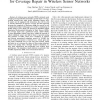Free Online Productivity Tools
i2Speak
i2Symbol
i2OCR
iTex2Img
iWeb2Print
iWeb2Shot
i2Type
iPdf2Split
iPdf2Merge
i2Bopomofo
i2Arabic
i2Style
i2Image
i2PDF
iLatex2Rtf
Sci2ools
135
click to vote
VTC
2010
IEEE
2010
IEEE
Randomized Robot-Assisted Relocation of Sensors for Coverage Repair in Wireless Sensor Networks
—In wireless sensor networks (WSN), stochastic node dropping and unpredictable node failure greatly impair coverage, creating sensing holes, while locally redundant sensors exist. If sensors are all equipped with locomotion, they will be able to relocate themselves to improve coverage. But this approach increases the complexity of hardware design for sensors as well as deployment budget. In this paper, we consider a small group of mobile robots to serve WSN. We propose an algorithm, named Randomized Robot-assisted Relocation of Static Sensors (R3S2), for coverage repair and a grid-based variant, called G-R3S2. By these algorithms, mobile robots move within the network to collect redundant sensors and deliver them to reported sensing hole positions. In R3S2, robots move completely at random and relocate encountered redundant sensors. In G-R3S2, the robots random movement is restricted on a virtual grid, and the robots continually move to the next least recently visited grid point so a...
Communications | Redundant Sensors | Robots | Sensors | VTC 2010 |
Related Content
| Added | 31 Jan 2011 |
| Updated | 31 Jan 2011 |
| Type | Journal |
| Year | 2010 |
| Where | VTC |
| Authors | Greg Fletcher, Xu Li, Amiya Nayak, Ivan Stojmenovic |
Comments (0)

